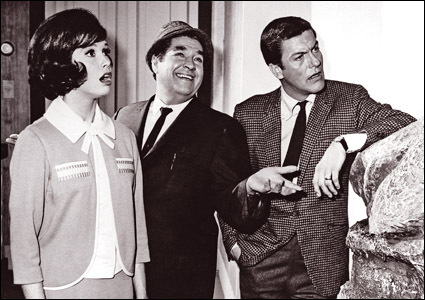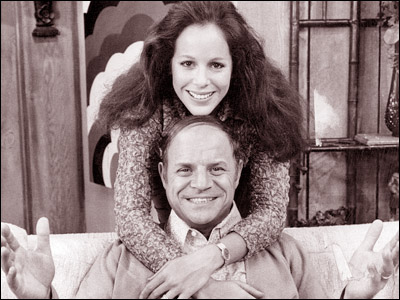From David Serchay, we have this question…
I've always been curious. When sitcoms are filmed in front of a studio audience, are they done so in continuity so the audience knows what's going on? In other words, do they go from the scene in home #1, then to home #2, then to the workplace set, and then back to homes #1 and 2? Or do they film all of the the home #1 scenes, all of the workplace scenes, etc.
Okay, here's my answer — and remember, we're only talking here about sitcoms filmed "three camera," which are sometimes done with more than three. These are sitcoms done in front of a live audience.
To the extent possible, "three camera" sitcoms go in order. In most cases, the live audience is seated in wide bleachers and in front of them are the sets for the various scenes placed side by side. This can mean that if you're seated way to the left, you might not have a great view of the action on the set at far right…but sometimes, there are monitors so you can watch those scenes on them. Of course, back in the fifties and sixties when most sitcoms were shot on film, there were no monitors.

When I went to that filming of The Dick Van Dyke Show in February of '65, there were three sets side-by-side. As you faced the stage, the set farthest to the right was the office in which The Alan Brady Show was written. It was probably there for most filmings. The other two sets were new to us because this episode was mainly a flashback sequence: Rob Petrie, sitting in his office with his accountant, told that accountant the story of how he and Laura had bought their house.
There was a scene in that office at the beginning of that episode in which Rob started telling the story and then they dissolved into the story he was telling which took place on the other two sets — the kitchen in which Rob and Laura then lived (the middle set) and the basement of the house they were thinking of buying (the set on the far left). So they started filming with the first office scene, then Dick Van Dyke changed his clothes and they filmed the flashback scenes in order in the other two sets.
Then Dick got back into the wardrobe of the first scene and they went back to the office set and filmed the last scene. Everything in sequence.

By contrast: In 1972, a bunch of my friends and I attended the filming of an episode of The Don Rickles Show…a short-lived sitcom he had that year. You may not remember this Don Rickles Show and neither did its producer, Sheldon Leonard. When Mr. Leonard wrote his autobiography, he mentioned every TV show he ever worked on except this Don Rickles Show. It was very similar in format and "look and feel" to The Dick Van Dyke Show which Mr. Leonard also produced and which he did remember.
I have never seen an episode of this show since it went off the air but here's the opening. They show the audience bleachers though I don't think this was from the night that my friends and I were there…
And now here's the plot of the episode we saw that night. I stole this off an online episode guide to the series…
Don becomes his own defense attorney in court when he pleads guilty to stealing a TV set and bases his defense on a "terrible explanation".
As aired, the episode started with Don being arraigned in a courtroom and he began a lengthy explanation of how he had purchased a TV set in a store and it hadn't worked. He took it back to the store and when they wouldn't take it back or fix it, he got mad and tried to take another set of the same model and that was when he was arrested. The first scene was him in the courtroom as he started explaining to the judge.
Then the flashback scenes started. This was similar in structure to an episode of The Dick Van Dyke Show called "The Case of the Pillow" in which Rob Petrie had to explain to a judge (played by Ed Begley Sr.) how Laura had bought some faulty pillows. That Van Dyke episode was written by Bill Persky and Sam Denoff. If you looked closely at the above opening of the Rickles show, you saw that it was created by Sam Denoff.
For the bulk of the Rickles show as aired, they cut back and forth between scenes in the courtroom and flashback scenes in Don's home, office and the store where he bought the TV. The last scene was in the courtroom.
At the filming, they did not do these in sequence. Mr. Leonard, who did the warm-up and hosted for the audience explained that they only had room on the stage for three sets and this episode called for four. So they filmed all the scenes in the home, office and store, then there was a fifteen-or-so minute break while they moved the office and store sets out and rolled in the courtroom set. Rickles changed into a different outfit and they filmed all the courtroom scenes.
And then, Sheldon Leonard asked us to stay and laugh it up as they filmed a new end scene to the episode they'd filmed the previous week. Rickles and Louise Sorel (who played his wife) changed into the clothes they'd worn in that episode and the filming also involved an actor named Henry Jones who had been in that episode. As they filmed that new scene, we all laughed even though we had no idea what was going on or why we were laughing.
This is not how "three camera" situation comedies are supposed to be done…but every once in a while, they are. It also became trendy in the last decade or so for a sitcom to do an occasional exterior scene which is shot without an audience and then they play it on the monitors for the live audience. I suspect that the closer they get to having the audience see everything in sequence, the better it always goes.
